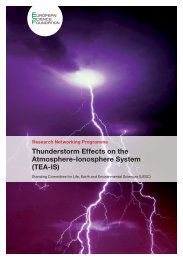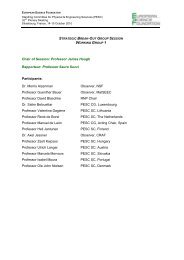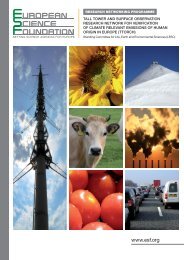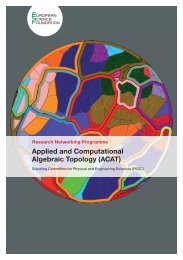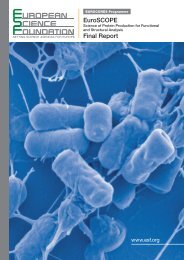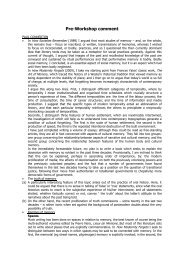European Peer Review Guide - European Science Foundation
European Peer Review Guide - European Science Foundation
European Peer Review Guide - European Science Foundation
Create successful ePaper yourself
Turn your PDF publications into a flip-book with our unique Google optimized e-Paper software.
16<br />
<strong>European</strong> <strong>Peer</strong> <strong>Review</strong> <strong>Guide</strong><br />
structure are: effectiveness, clarity and simplicity.<br />
The governance structure is meant not only to<br />
ensure that all the relevant players and stakeholders<br />
are made fully aware of their roles and assigned<br />
tasks, their expected contributions and their responsibilities<br />
but also to ensure that all contributions<br />
are made according to the required standards and<br />
within the scheduled deadlines. Finally, the governance<br />
structure is meant to be able to hold the<br />
relevant bodies accountable for any deviations or<br />
shortfalls.<br />
Some of the main attributes of credible and<br />
effective governance are outlined below:<br />
• Identification of the relevant actors, and clarification<br />
of the scope and levels of their responsibilities<br />
(e.g., decision makers, clients such as researchers<br />
and the public, other stakeholders such as regional<br />
or national governments);<br />
• Definition of roles and responsibilities of the key<br />
actors: programme officers, management committees,<br />
review panels, other decision making or<br />
consulting panels (such as ethical panels or monitoring<br />
panels or committees), readers, external<br />
observers, etc.;<br />
• Definition and dissemination of key decision making<br />
processes and approval processes;<br />
• Definition and dissemination of procedures to<br />
effect continuous improvement through appropriate<br />
changes to the process;<br />
• Availability and effective allocation of the required<br />
resources (financial, human resources, technical<br />
recourses and infrastructure, etc.);<br />
• Terms of reference and, if possible, code of conduct<br />
for all the participants (terms of appointment,<br />
confidentiality agreement, declaration of conflict<br />
of interest, integrity code, etc.).<br />
3.5 Methodology<br />
The final important pillar for achieving good<br />
practice in peer review is the actual adopted methodologies<br />
and approaches for conducting peer<br />
review. Since it is under ‘methodology’ that the<br />
main building blocks and common approaches<br />
of peer review are described, a dedicated chapter,<br />
Chapter 4, is provided to illustrate the different<br />
steps and the sequential order of the peer review<br />
process in a general sense.




